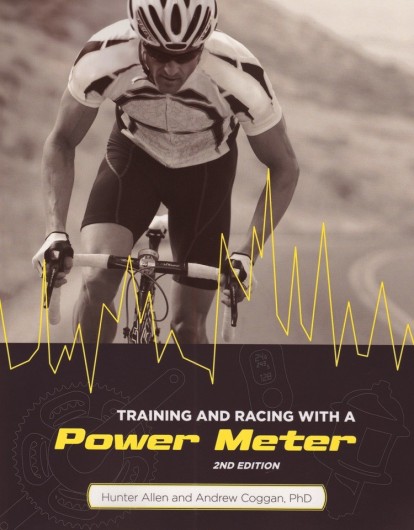 Standing central on the office bookcase’s sports shelf is a well used copy of Training and Racing with a Power Meter
Standing central on the office bookcase’s sports shelf is a well used copy of Training and Racing with a Power Meter by Hunter Allen and Andrew Coggan. Though it’s often referred to, it’s five years since I last read it cover to cover, but with the more recent second edition arriving on Kindle I decided it was time I revisited the power training text book. Not least for the additional content, including a chapter on triathlon, absent from my tired first edition paperback. A refresher of the book I frequently recommend was long overdue.
Irrespective of the update this book remains a companion piece to power meter ownership, there is, Internet resources aside, little real competition in the market. It is the guide, taking the reader from the point of considering training with power, through choosing a system, on to testing, planning and finally analysis. Training and Racing is a practical guide at heart, rarely becoming bogged down in unnecessary detail and filled with examples to demonstrate its point. There is enough within this relatively short manual to enable an athlete to effectively train with power and, more importantly, to understand why they are doing it. Exactly what the it did for me when I first bought a power meter.
For the beginner concepts are introduced in a logical and progressive order, with additional detail tending to be asides or boxed out. By chapter five they should be able to test themselves and to select appropriate workouts from the numerous examples provided in the appendices; by chapter ten they’re able to construct a more focussed plan and to assess their progress; and by the end of the book the reader has rounded out this knowledge with an understanding of using power meters to prepare for specific disciplines, triathlon being the significant one for this blog. All the foundations of my own experience of training with power are contained within these pages and while, on occasion, my approach has diverged, the book remains a reference. There is nothing here to guide you astray.
Chapter eleven, A Powerful Triathlete, covers the approach a triathlete should adopt in training. It’s a useful section in a book that otherwise deals with events requiring a mix of aerobic and anaerobic capacity. Instead, this chapter emphasises the development of threshold and aerobic endurance in training and the significance of pacing for race performance. There are many topics I’ve mentioned in this blog, but the book does a better job of introducing them. In addition to the basics of training and examples of developing pacing strategies, there’s a look at using the Performance Management Chart for both bike and run (like me, they’ve yet to incorporate swimming) and discussion of interpreting it in light of anticipated race performances. Again sound recommendations with a welcomed emphasis on pacing.
This is Allen and Coggan’s approach to power training ensuring a consistent viewpoint for the reader, but equally excluding any other viewpoints. Most significant is the association with WKO+, software originally developed by Allen. WKO+ is a powerful, if user-unfriendly, tool for analysing data, but it’s not the only tool available and were it not for a brief section of chapter two the reader might not realise this. Discussions of concepts like power profiling or the Performance Management Chart are presented as implemented in WKO+; true, this is where they were developed, but there are other options. As a long term WKO+ user this wasn’t a particular issue, but with WKO+ becoming increasingly relegated in place of the TrainingPeaks website (also not mentioned), it may pay to independently research alternatives.
For the uninitiated Training and Racing with a Power Meter is an obvious buy; for those, like me, who’ve owned the first edition there is more than enough new content here to merit an update. Triathlon chapter aside, newer concepts like fatigue profiling – a more detailed understanding of an athletes strengths – are introduced, as well as greater discussion of aerodynamic testing and quadrant analysis and, as mentioned, an extensive collection of example workouts in the appendices. The rewrite seems extensive, new content blends into old and despite my familiarity I found it an engaging read and came away with a few new ideas. Overall, a useful refresher.
There was never any doubt this book would receive a positive review. The beginner should take the time to understand power training and this is the book to start with, it’s also a comparatively small investment beside the power meter itself. Whether it had much to offer a long-term power user is another question, one that delayed me purchasing a copy until it became available in digital format. For the experienced user, there is nothing radical or new here (not least as the second edition has been out for over two years), but it remains a worthwhile text and an enjoyable read. If you own a power meter, you should read this book.
My copy of Training and Racing with a Power Meter, 2nd Ed. was purchased for Kindle at amazon.co.uk
.
